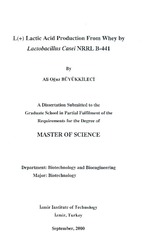Please use this identifier to cite or link to this item:
https://hdl.handle.net/11147/3461| Title: | L(+)lactic Acid Production From Whey by Lactobacillus Casei Nrrl B-441 | Authors: | Büyükkileci, Ali Oğuz | Advisors: | Harsa, Hayriye Şebnem | Publisher: | Izmir Institute of Technology | Abstract: | Lactic acid, its derivatives and poly-lactic acid are widely used in the industry. Lactic acid has been produced chemically or by fermentation for many years. However, there is a need to develop low cost production and purification methods. The development and use of processes with high productivity and product yield from inexpensive carbohydrate sources can lead to a more feasible lactic acid production.The goal of this work was to find the most suitable values of some fermentation parameters for lactic acid production from whey by an L-lactic acid producing bacterium, Lactobacillus casei. Whey is the by-product of cheese production and it is inexpensive and year-round available.Fermentations were conducted in the fermenter and shake flasks to determine the optimum values for temperature and pH. The highest lactic acid productivity values were obtained at 37 a1C and pH 5.5. The productivity was 2.0 g r1 h-1 at 37 a1C in the shake flask. In the fermenter, a productivity of 4.6 g r1 h-1 was obtained at pH 5.5. The effect of yeast extract concentration was also examined. Although the productivity values were found to be slightly higher (approximately 1.8-2.0 g r1 h-1 with 0.75 and 1.0% (w/v), 0.5% (w/v) yeast extract concentration with a productivity figure of 1.75 g r1 h-1 was concluded to be the most feasible concentration, since yeast extract is an expensive material.1. casei was tested for its capability to utilize different substrates, particularly whey, synthetic lactose and synthetic glucose. Whey yielded a higher productivity value of 1.75 g r1 h-1 than the synthetic sugars.The effect of initial substrate concentration on lactic acid production was examined up to 10% (w/v) whey lactose. Lactose was utilized completely for every initial substrate concentration examined in this study. Product yields were between 0.89-0.94 g lactic acid (g lactose r1 The salt effect was examined by discarding one of the salts (K2HP04, KH2P04, MgS04 or MnS04"H20) from the medium at each run. The lactic acid production was poor in the absence of MnS04.Seed culture that had the same composition as the fermentation medium was used as the inoculum for the fermenter. With this seed culture greater productivity values were obtained than the shake flasks, which were inoculated with litmus milk culture. In the shake flasks the highest productivity was around 2.0 g r1 h-1, while in the fermenter a productivity value of 4.6 g r1 h-1 could be obtained with 12.5% inoculum at pH 5.5. Biomass growth was investigated in lactose synthetic medium. The lactic acid production was associated with the biomass growth up to a certain time, but then a non-growth associated lactic acid production was observed. Maximum specific growth rate was calculated as 0.32 h-1. | Description: | Thesis (Master)--Izmir Institute of Technology, Biotechnology, Izmir, 2000 Includes bibliographical references (leaves: 62-65) Text in English;Abstract: Turkish and English xii, 68 leaves |
URI: | http://hdl.handle.net/11147/3461 |
| Appears in Collections: | Master Degree / Yüksek Lisans Tezleri |
Files in This Item:
| File | Description | Size | Format | |
|---|---|---|---|---|
| T000052.pdf | MasterThesis | 30.1 MB | Adobe PDF |  View/Open |
CORE Recommender
Page view(s)
408
checked on Aug 4, 2025
Download(s)
588
checked on Aug 4, 2025
Google ScholarTM
Check
Items in GCRIS Repository are protected by copyright, with all rights reserved, unless otherwise indicated.